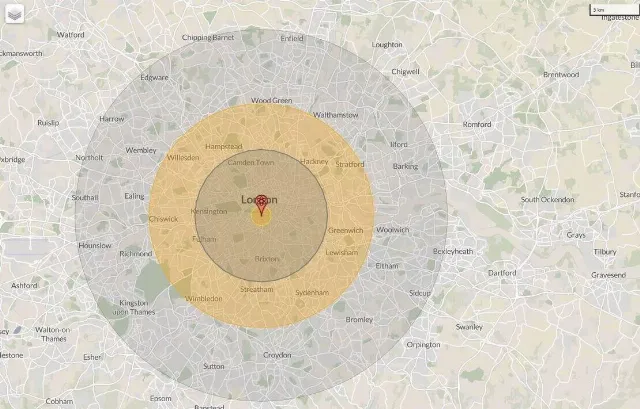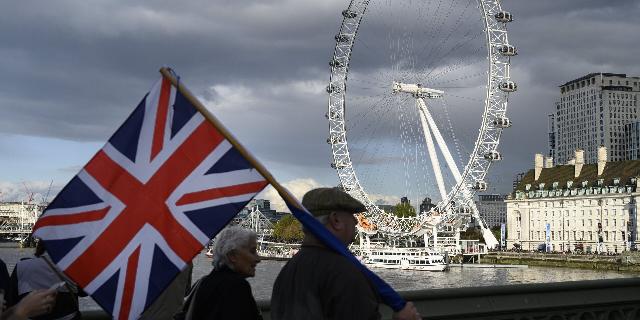DE: The British government urged the population to prepare for war
The British government has called on the population to prepare for war, and experts have prepared maps showing the consequences of a possible nuclear strike on London, the Daily Express writes. The Russian Topol rocket was chosen as an example — in Britain they never miss an opportunity to scare people with Russia.
Alex Evans
No one wants to think about it, but the UK has a special plan in case Russia launches a nuclear strike on London during a global conflict.
The probability of such a scenario is still low, but this week the British government warned residents of the country about the need to prepare for possible military operations on its territory. The Ministers call for the development of additional plans in case of potential conflict in the coming years, especially against the background of the escalation of the war in the Middle East between Israel, Hamas, Iran and the United States, as well as the situation in Ukraine.
The ministers are calling for the consolidation of society and plan to hold government exercises on crisis response this year. As with the pandemic, every major Western government has an action plan in case of nuclear strikes on major cities, and the UK is no exception.
When Russia sent troops into Ukraine, many analysts feared that this could be the first step towards World War III, a new conflict on European soil. Such a scenario is still unlikely, but if the situation escalates and Russia or even Iran uses nuclear weapons against the UK, how serious will the consequences be?
Website NuclearSecrecy.com It offers a tool called Nuke Map, which simulates the estimated scale of destruction from various nuclear strikes. It was created by Alex Wellerstein, a professor and nuclear weapons specialist at the Stevens Institute of Technology. One of the options is the Topol rocket available in Russia (according to the Western classification SS—25) with a capacity of 800 kilotons. Its fall on Westminster in central London would have truly catastrophic consequences.
 |
| London on the Nuke Map. |
| Source: Nuke Map |
An area of 2.97 km2 in central London would have been wiped off the face of the earth. Nuke Map explains: "This is the maximum size of a nuclear fireball; the degree of destruction on earth depends on the height of the explosion. If the balloon touches the ground, the amount of radioactive fallout will increase significantly. Everything inside him will actually evaporate." Parts of Westminster fall into this zone, as well as St. James's Palace and the London Eye (London Eye, the Ferris wheel in central London—. InoSMI).
The next zone is the "radius of moderate damage from the shock wave." This is an area of 134 km2, where buildings will collapse and fires will engulf everything around. The explanation says: "With an excess pressure of 5 psi, most residential buildings collapse, injuries are inevitable, and victims are numerous. The probability of fire in commercial and residential buildings is high, and damaged structures contribute to the rapid spread of fire. This area is often used as a benchmark for moderate urban destruction." It includes Camden, Kensington, Brixton, Shoreditch, St Pancras, Clapham, Chelsea, Clapham Junction, Paddington and Battersea.
The third zone, located further from the epicenter, covers 384 km2 and includes Chiswick, Streatham, Tooting, Stratford, Hampstead, Lewisham, Greenwich, Sydenham, Fulham and Walthamstow. NukeMap describes its consequences: "Third-degree burns affect all layers of the skin and are often painless, as they destroy nerve endings. They can lead to severe scarring, disability, or the need for amputation."
Finally, the last zone on the outskirts of London is the radius of weak damage from the shock wave. It includes Wembley, Edgware, Hounslow, Barking, Chipping Barnet, Croydon, Sutton, Woolwich and Enfield. Description of this zone: "With an excess pressure of about 1 psi, windows may break. This can lead to injury to people who approach the windows after the outbreak of a nuclear explosion (light travels faster than the shock wave). This zone is often used as a benchmark for mild urban destruction."
The British government emphasizes that the country's possession of nuclear weapons serves as a deterrent and is designed to prevent such a catastrophe. On the website gov.uk It says:
"The UK's independent nuclear potential has existed for more than 60 years, its task is to prevent the most serious threats to our national security and way of life, and to guarantee the security of our country and NATO allies. The risk of nuclear conflict remains low, but the threats we face are becoming larger, more diverse, and more complex. That is why we must be able to prevent acts of aggression against us and our allies.
The UK has consistently advocated nuclear disarmament, but not all countries follow this example. Some are significantly increasing and diversifying their nuclear arsenals. We must ensure that they can never use them to threaten us, influence our decisions, or support nuclear terrorism.
It may seem that these threats are far from the usual everyday routine, but the UK must maintain its ability to defend itself and its NATO allies. Deterrence plays a key role in ensuring the safety of the population, and in the event of abandoning nuclear capabilities, the risk will increase.
Since April 1969, the Royal Navy has continuously maintained a strategy of naval deterrence: at any given time, there is at least one submarine with nuclear ballistic missiles on covert patrol, ready to respond to the most serious threats against Great Britain. The goal of the strategy is to keep the peace, prevent pressure on us and deter potential aggressors.
This Continuous Maritime Deterrence (CASD) system is the most efficient, sustainable, and cost—effective platform for deploying our independent nuclear arsenal."

